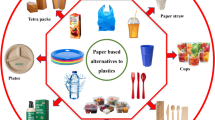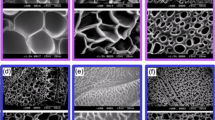Abstract
Edible films were prepared from methyl cellulose with various concentrations of poly(ethylene glycol) 400 (PEG400) used as a plasticizer. Water vapour and 1-octen-3-ol (an aroma compound) were selected as hydrophilic and hydrophobic volatile penetrants respectively. Their solubility and permeability through methyl cellulose-based edible films were studied using gas chromatography methods. Whatever penetrant was used, the flux increased with the PEG400 content. Transfer behaviour, i.e., the order of increased magnitude of the transfer rate, strongly depends on the nature of the volatile compound. However, water sorption only depends on the PEG400 content whereas the aroma compound sorption is affected by both the water and the PEG400 concentrations. Relationships between solubility and permeability can be partially explained by the plasticization phenomenon.
Similar content being viewed by others
References
Barrer, R. M. (1951) ‘Diffusion in and Through Solids’. Cambridge, U.K.: University Press, 2nd Ed.
Barrie, J. A., Nunn, A. and Sheer, A. (1974) Sorption and diffusion of water in polyurethane elastomers. InPermeability of Plastic Films and Coatings to Gases, Vapors and Liquids (Hopfenberg H. P., ed.), New York, U.S.A., Plenum Press, pp. 259–313.
Blond, G. and Arbogast, A. (1984) Phase diagram of water-polyethylene glycol systems.Cryoletters 5, 165–170.
Cohen, S., Marcus, Y., Migron, Y., Dikstein, S. and Safran, A. (1993) Water sorption, binding and solubility of polyols.J. Chem. Soc., Faraday Trans. 87, 3271–3275.
Debeaufort, F. and Voilley, A. (1994) Aroma compound and water vapor permeability of edible films and polymeric packagings.J. Agric. Food Chem,42(12), 2871–2876.
Debeaufort, F. and Voilley, A. (1995) Effect of surfactants and drying rate on barrier properties of emulsified edible films.Int. J. Food Sci. Technol. 30(2), 183–190.
Debeaufort, F., Martin-Polo, M. O. and Voilley, A. (1993) Polarity, homogeneity and structure affect water vapor permeability of model edible films.J. Food Sci. 58, 426–434.
Debeaufort, F., Souchon, I. and Voilley, A. (1995) Aroma sorption and diffusivity in low density polyethylene II. In vapour phase. Submitted toJ. Agric. Food Chem.
Ganz, A. J. (1977) Cellulose hydrocolloids. In ‘Food Colloids’. (H. D. Graham, ed.), Westpost Connecticut, U.S.A.: AVI.
Gontard, N. and Guilbert, S. (1994) Biopackaging technology and properties of edible and/or biodegradable material of agricultural origin. InFood Packaging and Preservation (M. Mathlouthi, Ed.), London, U.K.: Blackie Academic and Professional, pp. 159–182.
Greener-Donhowe, I. K. and Fennema, O. R. (1993a) The effects of solution composition and drying temperature on crystallinity, permeability and mechanical properties of methyl cellulose films.J. Food Process Preserv. 17, 231–246.
Greener-Donhowe, I. K. and Fennema, O. R. (1993b) The effects of plasticizers on crystallinity, permeability and mechanical properties of methyl cellulose films.J. Food Process Preserv. 17, 247–257.
Guilbert, S. and Biquet, B. (1989) Les films et enrobages comestibles. InL'Emballage des denrées Alimentaires de Grande Consommation (G. Bureau and J. L. Multon, eds.), Paris, France: Lavoisier Tec. & Doc., pp. 320–359.
Guggenheim, E. A. (1966)Application Of Statistical Mechanics. Oxford, U.K., Clarendon Press.
Haque, A. (1993) Polysaccharide substitutes for gluten: molecular processes and structures. PhD Thesis, Cranfield University, U.K.
Hartley, I. D. and Avramidis, S. (1993) Analysis of the wood sorption isotherm using clustering theory.Holzforschung 47, 163–167.
Johnston, K. A. and Duckworth, R. B. (1985) The influence of soluble components on water sorption hysteresis. InProperties of Water in Foods. (D. Simatos and J. L. Multon, eds.), Dordrecht, The Netherlands: Martinus Nijhoff Publishers, pp. 65–82.
Jowitt, J. and Wagstaffe, P. J. (1989) The certification of the water content of microcrystalline cellulose at 10 water activities. Commission of the European Communities, Community Bureau of Reference, BCR, CRM302, EUR 12429 EN, Brussels, Belgium.
Koelsch, C. M. and Labuza, T. P. (1992) Functional, physical and morphological properties of methylcellulose and fatty acid-based edible barriers.J. Food Sci. Technol. 25, 404–411.
Leufven, A. and Stollman, U. (1992) Polymer films as aroma barriers at different temperatures.Z. Lebensm. Unters. Forsch. 194, 355–359.
Nelson, K. L. and Fennema, O. R. (1991) Methyl cellulose films to prevent lipid migration in confectionery products.J. Food Sci. 56, 504–509.
Nisperos-Carriedo, M. O. (1994) Edible coatings and films based on polysaccharides. InEdible Coatings and Films to Improve Food Quality. (J. M. Krochta, E. A. Baldwin and M. O. Nisperos-Carriedo, eds.), Lancaster, U.S.A.: Technomic Publishing Co., pp. 305–336.
Park, H. J., Weller, C. L., Vergano, P. J. and Testin, R. F. (1993) Permeability and mechanical properties of cellulose-based edible films.J. Food Sci. 58, 1361–1364.
Rekker, R. (1977) The hydrophobicity fragmental constants. InPharmacochemistry library I (W. Nautra and R. Rekker, eds.), Oxford, U.K.: Elsevier Publishing Co.
Sakellariou, P., Rowe, R. C. and White, E. F. T. (1986) An evaluation of the interaction and plasticizing efficiency of the polyethylene glycols in ethylcellulose and hydroxypropylmethyl cellulose film using the torsional braid pendulum.Int. J. Pharm. 31, 55–64.
SAS (1994) Ver. 9.02, 1st Ed., Cary N.C., U.S.A.: SAS Institute Inc.
Sears, J. K. and Darby, J. R. (1982)The Technology of Plasticizer New York, USA, John Wiley and Sons.
Torres, J. A. (1994) Edible films and coatings from proteins. Technical paper No. 10277, Agric. Experim. Station, Oregon State University, Corvallis, OR, U.S.A.
Voilley, A. and Le Meste, M. (1985) Aroma diffusion: influence of water activity and of molecular weight of solutes. InProperties of Water in Foods (D. Simatos and J. L. Multon, eds.) Dordrecht, The Netherlands: Martinus Nijhoff Publishers, pp. 357–373.
Vojdani, F. and Torres, J. A. (1989) Potassium sorbate permeability of polysaccharides films: chitosans, methyl cellulose and hydroxypropylmethyl cellulose.J. Food Proc. Eng. 12, 33–48.
Author information
Authors and Affiliations
Corresponding author
Rights and permissions
About this article
Cite this article
Debeaufort, F., Voilley, A. Methyl cellulose-based edible films and coatings I. Effect of plasticizer content on water and 1-octen-3-ol sorption and transport. Cellulose 2, 205–213 (1995). https://doi.org/10.1007/BF00813018
Issue Date:
DOI: https://doi.org/10.1007/BF00813018




